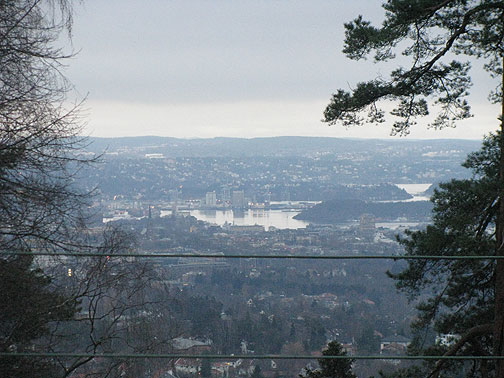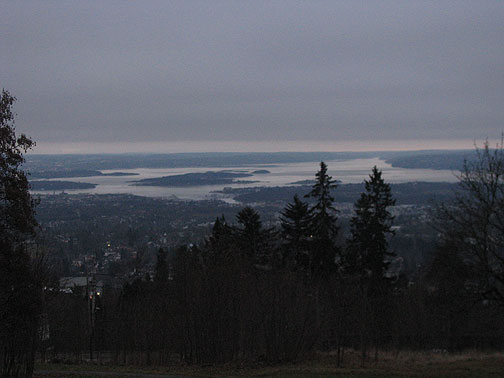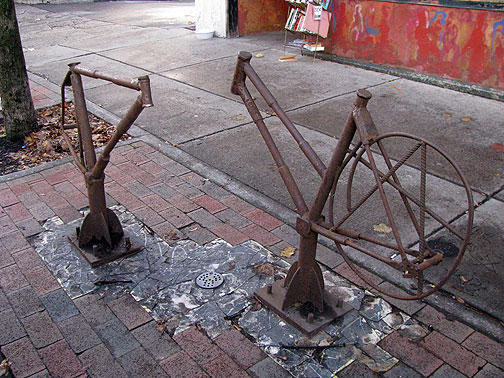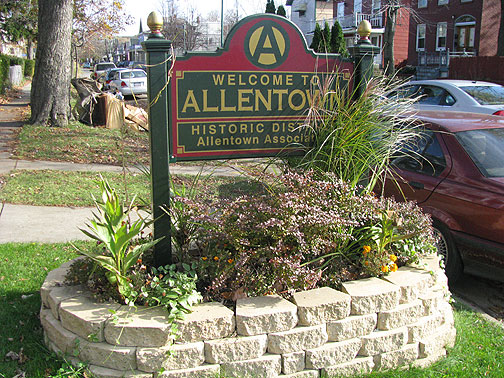Recent Posts
-
Yes, There IS a Future!
December 26, 2025
-
Real Crimes and the Coming Violence
September 6, 2025
-
Whither Modern Life?
June 27, 2025
-
What the Hell
June 18, 2025
-
As Darkness Engulfs Us
April 6, 2025
-
AI, Risk, and Work
January 17, 2025
-
“Things Are in the Saddle, and Ride Mankind”
December 29, 2024
-
Forgotten Futures in Seattle
December 12, 2024
-
Autocracy Defeats Neoliberalism
November 14, 2024
-
History… We’re Soaking in It!
October 2, 2024
|
We came to Oslo, Norway from Copenhagen (my first blog post from this trip appears here). It was supposed to be by train, but the Swedish National Railroads were repairing some tracks and due to surprising disorganization, we got stuck sitting in the Gothenberg central station for 4 hours waiting for a bus to run us up to Trollhatten where we could get back on a train. So the travel day was very long, but we were greeted by our hosts Audun and Tine, and have had a very nice visit here.
 A gray wintery city, Oslo only has daylight from about 8 am to 4 pm these days. On Saturday, I gave a Nowtopia talk as part of a “Social Change, Not Climate Change” talk at a local social center called Humla. About 20 people showed up, and I gave a shortened version of my usual talk since the point here is to fit it in a larger discussion about Climate politics. I shared billing with a couple of Swedes who came over from Stockholm to talk about their fascinating group called Planka.nu, which means something like “Crash it now!”, referring to their program of advocating free transit by jumping turnstiles and gates and not paying. The organization enrolls dues-paying members and if they get caught by the transit police without a paid fare, Planka pays their ticket. It’s a kind of insurance for free riders, and has its roots in both the anarcho-syndicalist youth movement (that has been around since the 1930s, and is connected to a national anarcho-syndicalist labor federation) and an autonomous Marxist think tank. I’ll write more about this later, probably in a full length report at Streetsblog after I interview them this week.
 Lots of water surrounding Oslo. Continue reading Up and Down in Oslo
 Buffalo, an animal and a city... Spent two and a half days in Buffalo, a place I’d never been before”¦ Always wondered why it was named Buffalo since that beast probably never roamed anywhere near here. Locals say it’s derived from a French expression Beau L’eau, with an “˜f’ somehow inserted into it by long lost accents”¦ the beautiful water of course would refer to the Niagara River meeting Lake Erie here, along with a variety of smaller waterways. Pouring through the Niagara Gorge, a famously beautiful natural rock formation, the waters then plunge over Niagara Falls a short way north of here.
I heard a lot about the local water from a woman I met last night, Katie B., who hails from Athens, Georgia. She works locally with a Riverwatcher nonprofit, helping local citizens monitor water quality in wetlands, creeks, and rivers hereabouts. She loves her job which she was anxious to tell me after my public appearance on a panel last night, where I gave my usual rant against useless, stupid work. It was at a place called “Sugar City,” mostly known as a punk rock venue. (Oddly it seemed like a sweet local art gallery much more than a punk venue, but I think that’s because they had to shut down for 3 months due to hostile neighbors, and are now reinventing themselves as a good neighbor.) It’s a great spot in one of Buffalo’s thriving districts, Allentown, full of historic architecture, a hopping bar scene at night, and a fine used bookshop, Rust Belt Books. The bookstore owner, Christie, told me in a brief conversation about the city, “Buffalo is not depressed. Buffalo is unimpressed!”
 Rust Belt Books in Allentown district of Buffalo, NY.  Cool rusting bike racks in front of Rust Belt Books.  Allentown District sign, with its surprising invitation to anarchists to be residents! True enough, it’s a town full of secret energies and a palpable sense of an interesting future embedded in a depopulated, often devastated landscape. This is after all the home of Love Canal and countless other lesser known toxic catastrophes (probably some still ahead). Buffalo was one of the most important cities in the U.S. back in the 19th century, first when the Erie Canal arrived in the early part of that century, and then during the long booms and busts of industrialization that followed. At its earliest moments around 1820 there was even a communal society that built a thriving village called Harmony on forested land purchased from the Seneca Indians, in an area now absorbed by the city of Buffalo.
Continue reading Frontiers Unfettered by Any Frowning Fortress: Nowtopian Buffalo
Been way too busy with the book project (Ten Years That Shook the City: San Francisco 1968-1978) and a fascinating oral history project (“Ecology Emerges”) that has had me doing sixteen interviews in the past few weeks… sorry for my poor blog here, which has lost out in the tussle for my time… anyway, wah wah wah.
 These are now available from me via my personal website... perfect for hanging on your bike as the oceans rise! I’m planning to be in Copenhagen at the Climate Conference (not inside, but outside) in December, and along with a whole lot of other folks on the planet, I’m thinking more and more about the dire facts piling up… We’ll be riding this Saturday in San Francisco along one possible future shoreline, as part of the thousands of actions across the country clamoring for meaningful policy change on Climate Change. We’re hosting a Talk next Wednesday at CounterPULSE on “Climate Change/Climate Justice” and I hope a lot of folks will come out for it.
I’ve been expecting to see a major rise in ocean levels in my life time, in spite of the commonly cited figures of a meter rise by 2100 or even less. I think it’s all going a lot faster than anyone can measure, and the synergistic reactions among different factors, like melting ice sheets, thawing arctic tundra, etc., are coalescing into a perfect storm. Inundation of coastal areas seems like it could happen rather suddenly, like within 10-20 years. Here’s a piece I came upon today that drives it home with a bit more science:
And what of that lodestone, global sea level? This happens to be a very interesting question, because ocean levels are set to rise dramatically. According to UCLA scientists, the last time carbon dioxide levels were as high as they are today was 15 million years ago. At that time, the sea level was between 20 and 36 metres higher (75 to 120 feet), there was no permanent ice cap in the arctic, and very little ice in Antarctica or Greenland. That is where we are headed. The only remaining question is, How long will it take us to get there?
The authors of the Hadley Centre report predict a rise of just 1.4 metres by 2100. The IPCC in their 2007 4th Assessment Report predicted something like half a metre by 2100 based on a combination of the fattening of the oceanic envelope caused by thermal expansion and the increased runoff from glaciers and minor ice sheets. None of this sounds particularly catastrophic just yet, but then it turns out that these predictions are not based on anything particularly relevant: the British Antarctic Survey, in 2008, made it clear that the IPCC had not included the source of nearly 100% of the world’s potential ice melt ““ the major ice caps of Antarctica and Greenland ““ simply because they had little idea of how the ice caps would behave in a heating world:
The Intergovernmental Panel on Climate Change (IPCC) highlighted the issue by suggesting that current knowledge is inadequate to estimate confidently the contribution that ice sheets might make to sea-level rise in coming centuries. While technology makes sea-level rise easier to observe, and we can predict some contributions to future sea-level rise with increasing certainty, we cannot yet fully predict the ice sheets’ contribution. There is thus a risk that sea-level rise could be higher than the (incomplete) estimates provided by the IPCC.
Thus, the most peer-reviewed piece of climate science ever written turns out to be completely inadequate when it comes to estimating the level of disruption associated with a very important aspect of climate change: the rising seas. If Antarctica contains 90% of the world’s land ice (sea ice, like that in the Arctic, does not directly cause the oceans to rise when it melts) and Greenland contains most of the rest, then what’s going to happen when they start to melt with a vengeance, and when are they going to start melting? Official science is mute on the subject.
 Our logo for Saturday's ride. Continue reading Future Shorelines
|
Hidden San Francisco 2nd EDITION!

NEW 2nd EDITION NOW AVAILABLE!
Buy one here
(Pluto Press, Spring 2025)
|



















